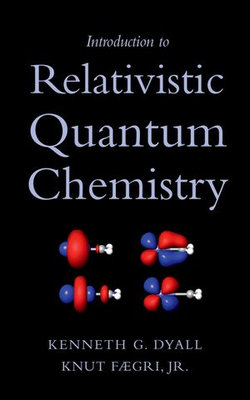
-
Books
-
Education
-
eBooks
-
Audio Books
-
Film & TV
-
Calendars, Diaries & Stationery
-
Giftshop

This book provides an introduction to the essentials of relativistic effects in quantum chemistry, and a reference work that collects all the major developments in this field. It is designed for the graduate student and the computational chemist with a good background in nonrelativistic theory. In… more
This book provides an introduction to the essentials of relativistic effects in quantum chemistry, and a reference work that collects all the major developments in this field. It is designed for the graduate student and the computational chemist with a good background in nonrelativistic theory. In addition to explaining the necessary theory in detail, at a level that the non-expert and the student should readily be able to follow, the book discusses the implementation of the theory and practicalities of its use in calculations. After a brief introduction to classical relativity and electromagnetism, the Dirac equation is presented, and its symmetry, atomic solutions, and interpretation are explored. Four-component molecular methods are then developed: self-consistent field theory and the use of basis sets, double-group and time-reversal symmetry, correlation methods, molecular properties, and an overview of relativistic density functional theory. The emphases in this section are on the basics of relativistic theory and how relativistic theory differs from nonrelativistic theory. Approximate methods are treated next, starting with spin separation in the Dirac equation, and proceeding to the Foldy-Wouthuysen, Douglas-Kroll, and related transformations, Breit-Pauli and direct perturbation theory, regular approximations, matrix approximations, and pseudopotential and model potential methods. For each of these approximations, one-electron operators and many-electron methods are developed, spin-free and spin-orbit operators are presented, and the calculation of electric and magnetic properties is discussed. The treatment of spin-orbit effects with correlation rounds off the presentation of approximate methods. The book concludes with a discussion of the qualitative changes in the picture of structure and bonding that arise from the inclusion of relativity.
lessThis item is delivered digitally
Thanks for reviewing Introduction to Relativistic Quantum Chemistry. We will process your review. Accepted reviews will be posted within 3-7 business days.
Be the first to know, stay up to date with what's trending and get staff picks in your inbox with our newsletter


Public: Allow anyone to view or shop your List
Private: No one can view or shop your List
We have kept your A&R details for your new Angus & Robertson account
We also noticed that you have previously shopped at Bookworld. Would you like us to keep your Bookworld order history?
We also noticed that you have an account on Bookworld. Would you like us to keep your Bookworld details, including delivery addresses, order history and citizenship information?
Share This eBook